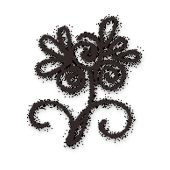Tradition
Sand sprinkled patterns became one of the elements of folk art characteristic for Kuyavian decorative art, distinguishing it among the neighbouring regions. This custom was known in Kuyavia from the second half of the nineteenth century. It spread after the abolition of serfdom with the increase of wealth among the village residents, which resulted in greater care of house interiors and yards. This form of decoration, passed from generation to generation, was women’s domain and it was widely popular among them. Young girls usually learnt this art from their mothers and grandmothers. Sand patterns were occasional decorations of rooms and yards; they emphasised exceptional nature of festival time and were part of pre-festival preparations. The patterns were sprinkled in Easter, Whitsun, on the occasion of church fairs, betrothal or visits of guests. Originally, sand decorations were sprinkled in the places which were the least exposed to treading, e.g. along room walls. In the interwar period sand patterns were made outside the house by marriageable girls, which were supposed to attract attentions of bachelors.
Sand Patterns, with the participation of Władysława Włodarzewska, 1970s.,
Świątkowice, author Wincenty Kaczalski,
Archives of Kuyavia and Dobrzyń Land Museum in Włocławek, 4:30 min.
The tradition of sand sprinkling was still alive in the 1950s in the surroundings of Włocławek, Kowal, Izbica Kujawska and Chodecz, in villages such as Bogołomia, Boniewo, Gajówka, Gołaszewo, Kruszyn, Śmiłowice, Świątkowice and in the South-East Kuyavia in the neighbourhood of Przedecz, among the others, in villages Rybno and Żarowo. It was limited only to decorating the closest area – the yard and small paths podróżka leading to the house. In the 1960s, when the tradition was basically extinct, it was reactivated thanks to sand art competitions and demonstrations organised since 1965 to the mid 1980s by the Kuyavia and Dobrzyń Land Museum in Włocławek, the Dobrzyń-Kuyavia Cultural Society and the Ethnographic Museum in Toruń. These institutions found and encouraged to participate in the above mentioned events around 30 folk women creators who had previously performed this form of art. The competition of 1972 brought especially interesting results with sand patterns which were created in the artists’ places of residence.
Sand Pattern Sprinkling. Tradition, Toruń, Przedecz, 2017,
production by: B. Olszewska, B. Oleszek, 5:30 min.


